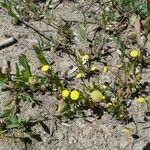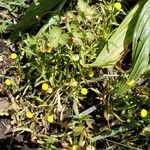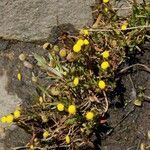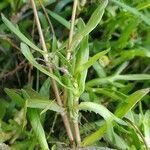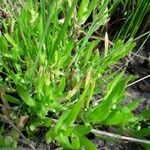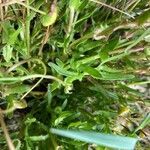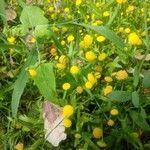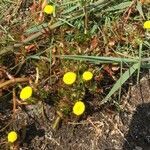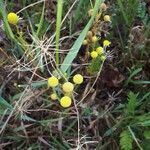Ascending to erect, fleshy, glabrous annual or short-lived perennial up to 30 cm tall. Stems terete, branched from base and above, up to 25-(40) cm long, rooting freely from lower nodes. Lvs fleshy, alternate, apetiolate, linear, lanceolate or spathulate, entire, with few irregular large lobes, or shallowly 1-(2)-pinnatisect, usually perfoliate, rarely amplexicaul, (10)-15-80 mm long; lvs above becoming shorter, more triangular, less often divided and more often amplexicaul. Involucral bracts in 2-3 rows, 4-6 mm long. Capitula solitary, bright yellow, (6)-8-10-(13) mm diam.; peduncles scarcely expanded at apex, solid, 2-7 cm long, c. 1 mm diam.; ♀ florets in 1 or < 1 row, pedicellate, with a corolla; ☿ florets numerous, subsessile, with flattened tubular corolla. Achenes all flattened, hairy on inner surface, glabrous on outer. Achenes of ♀ florets 1.5-2 × 1-1.2 mm; lateral angles with thick, corky, entire, marginal wings. Achenes of ☿ florets 1.1-1.2 × 0.5-0.6 mm; lateral angles thinly ribbed.
Perennials to c. 30 cm high, glabrous. Leaves to c. 8 cm long, acutely lobed or 1-pinnatisect, rarely entire with l: w ratio up to 8, or sub-2-pinnatisect. Capitulum 5–12 mm diam.; peduncle mostly 2–8 cm long, 0.3–1.0 mm wide (pressed specimens), not obconical distally; involucral bracts numerous; outer bracts narrowly ovate or oblong, 3–5 mm long, rounded at apex. Marginal florets numerous, c. 1-seriate, with pedicels 1–1.8 mm long tapering distally. Disc florets bisexual, numerous, with pedicels longer than wide; corolla c. 1 mm long; limb bright yellow. Achenes of marginal florets 1.5–2 mm long; faces broadly oblong, papillose on inner face; wing spongy, c. as broad as body. Achenes of disc florets c. 1.3 mm long, ±oblong, papillose on inner face.
Somewhat fleshy glab. perennial herb with stems branched from base. Stems and lowest branches decumbent, creeping and rooting, then erect to ascending, up to 3 dm. tall, but often reduced to < 10 cm. under adverse conditions. Lamina (12)-50-80 mm. long, entire, narrow-oblong to lanceolate, widened to amplexicaul base; or more usually irregularly pinnatifid with 3 to many pinnae or lobes. Scapes slender, axillary and terminal, of diverse length. Capitula ± 8-10 mm. diam.; phyll. membr., narrow-oblong, obtuse; receptacle ± convex, finally us. strongly so. Florets bright yellow, ♀in 1 series on slender flattened pedicels; disk-florets perfect, us.∞, hardly pedicelled. Achenes broad-cylindric, ± compressed, with broad spongy wings.
Essentially glabrous, somewhat succulent perennial 5–30 cm tall, often trailing; lvs sessile, with subscarious sheathing base, entire or with a few coarse teeth or deep narrow lobes, narrowly oblong or lanceolate to linear, 1–6 cm × 1–10 mm, or broader when lobed; heads solitary at the ends of the branches; disk 5–11 mm wide; pistillate fls in a single series, without cor; achenes of the outer fls broadly winged, shorter than the stipe, the others merely 2-nerved, short-stipitate, the stipes persistent on the receptacle; 2n=20. Tidal flats, wet meadows, and other moist places; native of S. Afr., occasionally found from Que. to Mass. in our range. July–Aug.
Ascending or decumbent annual or perennial herb, 300-500 mm high, rooting at nodes. Leaves alternate, broadly linear or sublanceolate, irregularly toothed to bipinnatisect, succulent, sheathing at base. Capitula disciform, solitary, on slender, minutely leafy peduncles; involucral bracts in several rows, linear, obtuse, with membranous tip. Outer female florets in 1 row, corolla absent. Disc florets 4-lobed, bright yellow. Flowering time Aug.-May. Pappus absent. Cypselae of outer female florets winged and emargi-nate, those of disc florets turbinate.
Erect or sprawling perennial, up to 300 mm tall, often rooting at nodes, stems thick. Leaves alternate, sheathing at base, irregularly toothed to bipinnatisect, ± succulent. Flowerheads disciform, solitary on slender, minutely leafy peduncles; outer female florets in 1 row, corolla absent; disc florets bisexual, bright yellow. Cypselas of outer female florets winged and notched, of disc florets top-shaped; pappus absent.
Ascending or decumbent herb, 300-500 mm tall. Leaves broadly linear or sublanceolate, irregularly toothed, sheathing at base. Heads solitary; involucral bracts linear, obtuse, with membranous tip. Flowers bright yellow.
Erect or sprawling annual to 30 cm. Leaves alternate, sheathing at base, irregularly toothed to bipinnatisect. Flower heads disciform, solitary, on slender, minutely leafy peduncles, bright yellow.
